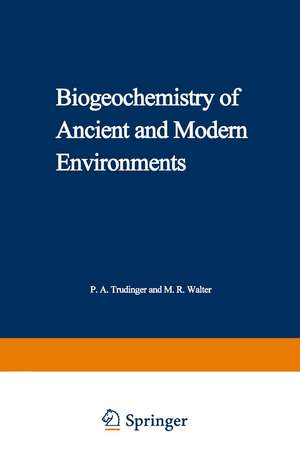Biogeochemistry of Ancient and Modern Environments: Proceedings of the Fourth International Symposium on Environmental Biogeochemistry (ISEB) and, Conference on Biogeochemistry in Relation to the Mining Industry and Environmental Pollution (Leaching Conference), held in Canberra, Australia, 26 August – 4 September 1979
Editat de P. A. Trudinger, M. R. Walter, B. J. Ralphen Limba Engleză Paperback – 1980
| Toate formatele și edițiile | Preț | Express |
|---|---|---|
| Paperback (2) | 413.54 lei 43-57 zile | |
| Springer Berlin, Heidelberg – 1980 | 413.54 lei 43-57 zile | |
| Springer Berlin, Heidelberg – 14 mai 2012 | 667.20 lei 43-57 zile |
Preț: 413.54 lei
Nou
Puncte Express: 620
Preț estimativ în valută:
79.13€ • 82.84$ • 65.48£
79.13€ • 82.84$ • 65.48£
Carte tipărită la comandă
Livrare economică 07-21 aprilie
Preluare comenzi: 021 569.72.76
Specificații
ISBN-13: 9780858470620
ISBN-10: 0858470624
Pagini: 726
Ilustrații: IX, 726 p. 70 illus.
Dimensiuni: 155 x 235 x 38 mm
Greutate: 1.02 kg
Ediția:Softcover reprint of the original 1st ed. 1980
Editura: Springer Berlin, Heidelberg
Colecția Springer
Locul publicării:Berlin, Heidelberg, Germany
ISBN-10: 0858470624
Pagini: 726
Ilustrații: IX, 726 p. 70 illus.
Dimensiuni: 155 x 235 x 38 mm
Greutate: 1.02 kg
Ediția:Softcover reprint of the original 1st ed. 1980
Editura: Springer Berlin, Heidelberg
Colecția Springer
Locul publicării:Berlin, Heidelberg, Germany
Public țintă
ResearchCuprins
Opening address: An outside view of environmental biogeochemistry.- Early biogeochemical systems: keynote address.- Precambrian genetics.- The universe of porphyrins.- Antiquity of photosynthesis: possible constraints from Archaean carbon isotope record.- Oxygen and ozone evolution in palaeoatmospheres.- Past oxygen levels; some evidence from uranium deposits.- Timing and relationships among Precambrian crustal and atmospheric evolution and banded iron-formations.- Chemical conditions for the precipitation of banded iron-formations.- Environmental biogeochemistry: keynote address.- Lake sediments: chemical composition and some aspects of their formation and diagenesis.- Lake sediments: algal availability of Lake Burley Griffin sediment phosphorus.- Bacterial populations in two saline Antarctic lakes.- Measurement of bacterial biomass in sandy sediments.- Carbon flow within the southwest arm of Port Hacking, N.S.W..- In situ experimentation with anaerobic sediments: some biogeochemical applications.- Sedimentological and geobiological studies of intertidal cyanobacterial mats in north-eastern Spencer Gulf, South Australia.- The microbial geochemistry of Solar Lake, Sinai.- Comparative organic geochemical studies of recent algal mats and sediments of algal origin.- Comparative analysis of stromatolitic and other microbial kerogens by pyrolysis — hydrogenation — gas chromatography (PHGC).- Lipid productivity of a high Andean lake.- The contribution of the chlorophyll-carotenoid protein complexes of brown seaweeds to the petrogenic silt of the oceans.- Biological methanogenesis in sediments and sanitary landfills.- Role of methane-producing and sulfate-reducing bacteria in the destruction of organic matter.- Methane in a saline Antarctic lake.- The production ofmethylated sulfur compounds by marine phytoplankton.- Influence of selenium compounds on the reduction of sulfur compounds and associated sulfur isotope fraction in Clostridium pasteurianum.- Microbiological nitrous-oxide production: implications for the global nitrogen cycle.- Mechanisms of nitrous oxide production in soils.- The measurement of denitrification in soil using 13NO3.- Nitrogen diagenesis in marine sediments: evidence for suboxic and anoxic conversion of organic N to N2 gas.- Regional nitrogen mass balance model for the Florida peninsula.- Process controlling the nitrogen cycle in the atmosphere over Australia.- Different forms of microbial manganese oxidations and reductions and their environmental significance.- The role of surface attachment in manganese oxidation by freshwater hyphomicrobia.- Electron transfer coupled to Mn(II) oxidation in two deep-sea Pacific Ocean isolates.- Electron microscopic analysis of metal-depositing microorganisms in surface layers of Baltic Sea ferromanganese concretions.- Mineralogical, geochemical, and microbiological aspects of iron deposition from ground water.- Consequences of anaerobiosis on metal-organic interactions in two ponds of the southeastern United States.- Physico-chemical models for heavy metal transport in streams.- Man’s effect on stratospheric ozone.- The trace composition of the atmosphere and the global atmospheric ozone content.- Effects on the carbon cycle due to human impact on forest ecosystems.- Sewage sludge fertilization in pine forests: ecological effects on soil and vegetation.- Polychlorinated biphenyls in sediments and mussels from Port Philip Bay, Victoria, Australia.- Water pollution as a consequence of land disturbance in south-west of Western Australia.- Interpretation of soil waterquality for agricultural production.- Facultative thermophilic Thiobacillus-like bacteria in metal leaching.- The leaching of sulfide ores by a thermophilic bacterium.- A scanning electron microscopy study of the colony morphology of Thiobacillus ferrooxidans.- A micro-calorimetric study of U(IV)-oxidation by Thiobacillus ferrooxidans and ferric iron.- A micro-calorimetric study of the metabolic activity of several Thiobacillus species.- Leaching of copper-bearing mineral substrates with wild microflora and with laboratory-bred strains of Thiobacillus ferrooxidans.- Isolation of iron- and sulfur-oxidising bacteria from mine water in Japan and some investigations on the leaching of sulfide ores.- The microbial role in pyrite oxidation at alkaline pH.- The effect of chemical and biological redox reactions on the growth of Thiobacillus thiooxidans.- Inhibition by pyrite of bacterial iron oxidation activity.- Sulfur and hydrogen ion buffering in pyritic strip-mine spoil.- Liquid dispersion in trickle flow through ore dumps.- The comparison of biological and chemical leaching: Heap leaching using Thiobacillus thiooxidans.- A reactor system for mineral leaching investigations.- A multi-company sponsored research program to study the biologically assisted ferric iron leaching of uranium minerals.- Bacterial leaching of a carbonate-bearing uranium ore.- Influence of attrition grinding on the recovery of copper from a high-grade chalcopyrite concentrate by the BSE-process.- Laboratory studies on mineral leaching.- An efficient method for the production of leaching medium.- Bacterial leaching of manganese ores.- Bacterial leaching of antimony and bismuth-containing ores and sewage utilization.- Water movement caused by monsoonal rainfall in an overburden dump undergoing pyriticoxidation.- Temperature distribution in an overburden dump undergoing pyritic oxidation.- Environmental studies of flooded opencuts.- Factors in metal leachate toxicity.- Biological methods to remove selected inorganic pollutants from uranium mine waste water.- Biochemical beneficiation of mining industry effluents.- Control of environmental pollution from mining wastes(metalliferous muds, Red Sea).- Desulfurization of coal by Thiobacillus ferrooxidans.- Mine waste pollution control at Captains Flat.- The revegetation of mine spoil.















